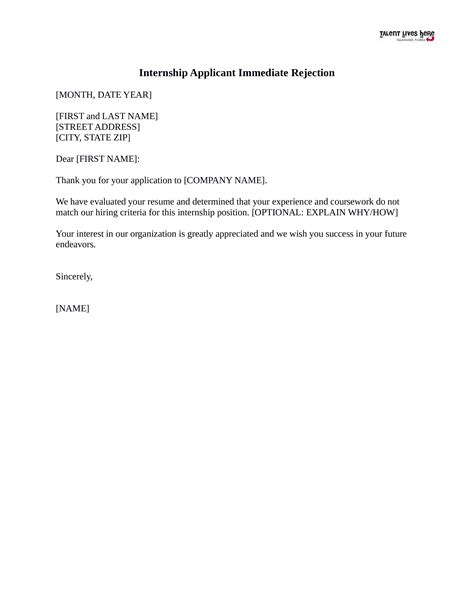Receiving an internship rejection letter can be a disheartening experience, but it’s important to remember that it is a common occurrence. According to the National Association of Colleges and Employers (NACE), only 44% of graduating college seniors secure an internship offer.

Understanding Rejection
Rejection letters serve multiple purposes. They formally communicate the hiring decision, provide feedback for improvement, and maintain professionalism. While the content of each rejection letter varies, they typically follow a standard structure:
1. Opening: Politely acknowledges your application and expresses gratitude for your interest.
2. Decision: Clearly states that you have not been selected for the internship opportunity.
3. Reason (Optional): May include specific reasons for the rejection, such as lack of relevant experience, skills, or qualifications.
4. Feedback (Optional): Offers constructive criticism to help you improve your applications for future opportunities.
5. Closing: Reasserts the employer’s appreciation and encourages you to continue your job search.
Coping with Rejection
Coping with internship rejection can be challenging, but there are several effective strategies:
1. Allow Yourself Time to Grieve: Acknowledge your disappointment and allow yourself to experience the emotions that come with it.
2. Seek Support: Talk to friends, family, or a career counselor for support and to process your feelings.
3. Analyze the Feedback: If provided, carefully consider the reasons for rejection and use them as opportunities for self-improvement.
4. Reframe Your Perspective: Focus on the positive aspects of your application and the valuable lessons you learned from the process.
5. Move Forward: Use the rejection as motivation to strengthen your applications and enhance your qualifications for future opportunities.
Tips for Crafting a Rejection Letter
If you’re responsible for writing internship rejection letters, follow these guidelines:
1. Be Timely: Respond promptly to candidates to demonstrate respect and avoid unnecessary anxiety.
2. Customize: Tailor the letter to each applicant, addressing them by name and referencing their specific application.
3. Be Clear and Direct: State the decision clearly and avoid using vague or ambiguous language.
4. Provide Feedback (Optional): Offer specific and constructive feedback if it can benefit the applicant in their job search.
5. Maintain Positivity: Express appreciation for the candidate’s time and effort, and encourage them to continue their job search.
Common Mistakes to Avoid
Avoid these common mistakes when writing internship rejection letters:
1. Automation: Avoid using generic or automated rejection letters. Personalized messages demonstrate respect for candidates.
2. Negativity: Refrain from using negative or judgmental language that could discourage candidates from applying in the future.
3. Lack of Detail: Provide specific reasons for rejection to help candidates understand where they may need to improve.
4. Unresponsiveness: Not responding to applicants can damage your employer’s reputation. Respond to all applications, even if it’s with a rejection letter.
5. Lack of Professionalism: Maintain a professional tone throughout the letter, avoiding colloquialisms or slang.
Step-by-Step Approach to Writing Rejection Letters
1. Gather Information: Collect the candidate’s name, application details, and any feedback from the hiring team.
2. Draft the Opening: Begin with a polite acknowledgment and express gratitude for the candidate’s interest.
3. State the Decision: Clearly state that the candidate has not been selected for the internship position.
4. Provide Feedback (Optional): If appropriate, provide specific and constructive feedback to help the candidate improve their applications.
5. Close the Letter: Reiterate your appreciation and encourage the candidate to continue their job search.
6. Proofread and Send: Carefully review your letter for errors before sending it to the candidate.
Tables
Table 1: Statistics on Internship Rejection Rates
| Source | Internship Rejection Rate |
|---|---|
| NACE | 56% |
| CollegeBoard | 62% |
| Glassdoor | 71% |
Table 2: Feedback Commonly Provided in Rejection Letters
| Reason | Percentage of Candidates Receiving Feedback |
|---|---|
| Lack of Relevant Experience | 42% |
| Insufficient Skills or Qualifications | 35% |
| Unimpressive Application Materials | 28% |
Table 3: Tips for Coping with Internship Rejection
| Tip | Description |
|---|---|
| Allow Time for Grief | Acknowledge and process your disappointment. |
| Seek Support | Talk to a trusted friend, family member, or career counselor. |
| Analyze the Feedback | Use rejection as an opportunity to identify areas for improvement. |
| Reframe Your Perspective | Focus on the positive aspects of your application and the lessons learned. |
| Move Forward | Use the rejection as motivation to strengthen your applications for future opportunities. |
Table 4: Common Mistakes to Avoid in Rejection Letters
| Mistake | Description |
|---|---|
| Automation | Avoid using generic or automated rejection letters. |
| Negativity | Refrain from using negative or judgmental language. |
| Lack of Detail | Provide specific reasons for rejection to help candidates understand where they may need to improve. |
| Unresponsiveness | Not responding to applicants can damage your employer’s reputation. |
| Lack of Professionalism | Maintain a professional tone throughout the letter, avoiding colloquialisms or slang. |
